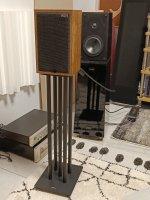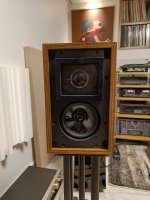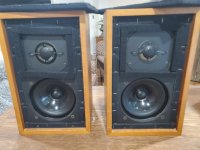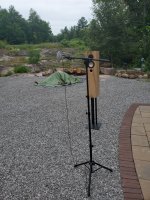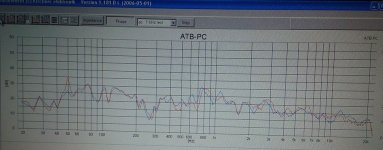For some reason they also sounded like more sensitive when we swapped from the Gold Badge Falcons without touching the volume control on the Leben amplifier (both are 15Ω nominal models using the output transformer's 16Ω tap). But I reserve to measure them with a mic and a high damping factor solid state amplifier vs the Falcons after some hours of run in. Next time.
2 days ago a neighbor handed me Rogers LS3/5A speakers along with a Quad 805 amp and pre and FM3
The pieces came from England when He moved here and were stored in boxes for many years
He would like my advice on what He should do with the pieces.
I hooked up LS3 immediately, listened and made some acoustic measurements indoors. Indoor response shaped is upward tilted toward spectrum extremes
They sound amazing and are generally accurate speakers but tilted upward. The bass bump isnt bothersome
Superb detail and smooth. Bass does not color or mask the midrange. Low bass lacking on some recording but not so much on others - Low to medium volume listening.
Could be bias as my interest/passion is cemented in a preference for only direct radiators!
For me these speaker show that accurate speaker designing has not changed for many decades. Marketing concepts of new and different produced grossly inferior speakers through 1980's and beyond.
Conservatively the LS3 sells for $3,000
Planning to integrate these with bass cabinets for active 3ways.. 300Hz cross could work nicely.
Or, I simply build him 3way's as $3k+ will go along way towards that option.. - will see
Attached is outdoor measurements along with speakers I built.. LS3/5A with off axis to 45 deg and impedance.. LS3/5A on axis and M5A 2way. M5A 2way has approx same sensitivity. Curve was raised..
The pieces came from England when He moved here and were stored in boxes for many years
He would like my advice on what He should do with the pieces.
I hooked up LS3 immediately, listened and made some acoustic measurements indoors. Indoor response shaped is upward tilted toward spectrum extremes
They sound amazing and are generally accurate speakers but tilted upward. The bass bump isnt bothersome
Superb detail and smooth. Bass does not color or mask the midrange. Low bass lacking on some recording but not so much on others - Low to medium volume listening.
Could be bias as my interest/passion is cemented in a preference for only direct radiators!
For me these speaker show that accurate speaker designing has not changed for many decades. Marketing concepts of new and different produced grossly inferior speakers through 1980's and beyond.
Conservatively the LS3 sells for $3,000
Planning to integrate these with bass cabinets for active 3ways.. 300Hz cross could work nicely.
Or, I simply build him 3way's as $3k+ will go along way towards that option.. - will see
Attached is outdoor measurements along with speakers I built.. LS3/5A with off axis to 45 deg and impedance.. LS3/5A on axis and M5A 2way. M5A 2way has approx same sensitivity. Curve was raised..
Attachments
Did you save any indoors charts to post?I hooked up LS3 immediately, listened and made some acoustic measurements indoors. Indoor response shaped is upward tilted toward spectrum extremes
They sound amazing and are generally accurate speakers but tilted upward. The bass bump isnt bothersome
I made an homage to the LS3/5A with modern readily available drivers and my own crossover that mimics the voicing and step response. My cabinet is a tad deeper so a bit more bass.
https://www.diyaudio.com/community/threads/rst28f-and-dc130a-foamcore-homage-to-ls3-5a.359176/
Full plans and build details in thread.


I have also adapted the same drivers and baffle to a TL with bass down to 43Hz. Same XO:

If you add a 1.5in dia x 3.2in long port to the sealed box above, it should bring bass down to 67Hz. Vunce was looking into this.
https://www.diyaudio.com/community/threads/rst28f-and-dc130a-foamcore-homage-to-ls3-5a.359176/
Full plans and build details in thread.
I have also adapted the same drivers and baffle to a TL with bass down to 43Hz. Same XO:
If you add a 1.5in dia x 3.2in long port to the sealed box above, it should bring bass down to 67Hz. Vunce was looking into this.
I will take again this week. They were open in the program, then Microsoft updated my laptop and then poof, gone..Did you save any indoors charts to post?
The majority of licensed LS3/5A I have taken or seen measurements for after the upper bass bump they recess until about 1kHz then keep relatively level but after 5kHz they tend to pick up again. Possibly to counterbalance the trademark upper bass bump that makes them seem bigger. Else they would have sounded dull.They sound amazing and are generally accurate speakers but tilted upward. The bass bump isnt bothersome
Superb detail and smooth. Bass does not color or mask the midrange. Low bass lacking on some recording but not so much on others
Because we will also measure the brand new Rogers SE indoors at a point and it will be interesting to see if Rogers kept their legacy FR trend or not. Don't know if that's absolutely possible with reverse engineered drivers and panzerholz baffle though. What I subjectively know is the SE sounds more even with more midrange information than the Falcon GB which in turn sounds bigger and emptier but deeper like having a more pronounced low bump and treble peak. I listened to the SE again for few hours after it had played for many days at my friend's. And we switched Rogers with Falcon back and forth.I will take again this week. They were open in the program, then Microsoft updated my laptop and then poof, gone..
Perhaps I missed it but, nobody has mentioned ATC as an alternate choice, which surprises me.
Back circa 1978 I was living in Nashville and I heard the Chartwell LS3/5As at Nicholson's of Nashville, a combination record store and legacy Mom & Pop hi-fi store, dating back to the hi-fi era. They had an original McIntosh mono amp on display. I was stunned at the (LP) playback of Maurice André's Fasch trumpet concerto, and also the price, which IIRC was $735 the pair or so. Which to me suggested that Nicholson's had bought them in New York at retail, in order to be the first to have them in Music City.
I ended up writing both for TAS and then later Stereophile, a total of more than 20 years, and I also had my own boutique classical audiophile LP and CD label. So, British monitor speakers of all kinds, including IMF, were obsessions.
If someone wants a modern, totally professionally worked out (and somewhat affordable) loudspeaker from that heritage, my advice is buy the biggest ATC you can afford. The smaller models (model numbers are displacement in Liters) are sealed boxes; the larger ones are vented. The US$3250/pr. SCM19 is a big favorite of mine.
But perhaps you will really want the smallest? There are lots of reviews linked to here:
https://www.lonemountainaudio.com/loudspeakers/entry-series/scm7/ (Music Direct seems not to stock the SCM7.)
Ah, these guys can get the SCM7, but it is a special order item @ $1350 the pair:
https://soundapproach.com/atc-scm7-entry-series-2-way-passive-bookshelf-speakers-pair.html
If you look up ATC on Stereophile.com, you can see what I wrote, and JA measured at least a few of them.
Best of luck.
john
Back circa 1978 I was living in Nashville and I heard the Chartwell LS3/5As at Nicholson's of Nashville, a combination record store and legacy Mom & Pop hi-fi store, dating back to the hi-fi era. They had an original McIntosh mono amp on display. I was stunned at the (LP) playback of Maurice André's Fasch trumpet concerto, and also the price, which IIRC was $735 the pair or so. Which to me suggested that Nicholson's had bought them in New York at retail, in order to be the first to have them in Music City.
I ended up writing both for TAS and then later Stereophile, a total of more than 20 years, and I also had my own boutique classical audiophile LP and CD label. So, British monitor speakers of all kinds, including IMF, were obsessions.
If someone wants a modern, totally professionally worked out (and somewhat affordable) loudspeaker from that heritage, my advice is buy the biggest ATC you can afford. The smaller models (model numbers are displacement in Liters) are sealed boxes; the larger ones are vented. The US$3250/pr. SCM19 is a big favorite of mine.
But perhaps you will really want the smallest? There are lots of reviews linked to here:
https://www.lonemountainaudio.com/loudspeakers/entry-series/scm7/ (Music Direct seems not to stock the SCM7.)
Ah, these guys can get the SCM7, but it is a special order item @ $1350 the pair:
https://soundapproach.com/atc-scm7-entry-series-2-way-passive-bookshelf-speakers-pair.html
If you look up ATC on Stereophile.com, you can see what I wrote, and JA measured at least a few of them.
Best of luck.
john
I have a pair of KEF B110 myself.
It was one of the first speakers I learned how to make an measure my own crossover filters.
I have always made that system a BR from the beginning. I personally never liked the closed box with a big hump.
I liked the T27 tweeters even less, they match very poorly with the B110.
The woofers have a kinda early breakup mode, which requires a tweeter to be crossed around 2,5kHz or less.
The T27 distortion isn't that great either unfortunately.
The B110's are great candidates for a ported design. The Qt is almost ideal.
I never understood why they never implemented it in the original design.
I still have them around for nostalgic reasons, but compared to modern drivers it's no match.
It was one of the first speakers I learned how to make an measure my own crossover filters.
I have always made that system a BR from the beginning. I personally never liked the closed box with a big hump.
I liked the T27 tweeters even less, they match very poorly with the B110.
The woofers have a kinda early breakup mode, which requires a tweeter to be crossed around 2,5kHz or less.
The T27 distortion isn't that great either unfortunately.
The B110's are great candidates for a ported design. The Qt is almost ideal.
I never understood why they never implemented it in the original design.
I still have them around for nostalgic reasons, but compared to modern drivers it's no match.
My friend with the BBCs also had the ATC SCM20SL in the same room which was very flat and true IMO but he never really loved it and he eventually sold it to a guy who has a music studio. It did not sound as friendly as an LS3/5A at low to medium volumes to him, it sounded good in high SPL was his conclusion. The studio guy fed back that it proved perfect for mixing in his heavily treated studio room but no good in domestic use that he also tried it. Too dry in that use they both say.Perhaps I missed it but, nobody has mentioned ATC as an alternate choice, which surprises me.
I wonder what the on-axis frequency response of this model is like, and how it compares to the original LS3/5A.Here's the Rogers LS3/5A Classic SE with panzerholz baffle. I listened to it for a couple of hours. It sounds resolute dynamic and smooth.
That's true, as the Qts of 0.31 for the B110A and 0.33 for the B110B makes a QB3 alignment an attainable choice. Their Vas is around 24 litres, so the vented enclosure would be relatively compact. With an Fs of around 35 Hz, a –3dB point in the vicinity of 50Hz would not be unusual.The B110's are great candidates for a ported design. The Qt is almost ideal.
For the B110, there is a tolerance of ±2 Hz on Fs. That might make the vented-box system a little sensitive to driver variations, while the sealed enclosure would be more tolerant to such variations. Maybe also the orginal design called for less low-frequency output than would be provided by a vented box enclosure?I never understood why they never implemented it in the original design.
Last edited:
By the way I forgot, measure them with the grills on next time. That's their intended configuration. The grill frame hugs the felt frame around the tweeter right up to the protruding cabinet edges helping with HF diffraction.I will take again this week. They were open in the program, then Microsoft updated my laptop and then poof, gone..
In many rooms there is a dip around 200hz. Some dB more here makes the sound more friendly.
Example, suckout 260hz
https://www.diyaudio.com/community/...oupled-up-firing-speakers.121385/post-6707993
Example, suckout 260hz
https://www.diyaudio.com/community/...oupled-up-firing-speakers.121385/post-6707993
Attachments
There is nothing strange about those tolerances. The average tolerance of an average woofer is about 10% by default.For the B110, there is a tolerance of ±2 Hz on Fs. That might make the vented-box system a little sensitive to driver variations, while the sealed enclosure would be more tolerant to such variations. Maybe also the orginal design called for less low-frequency output than would be provided by a vented box enclosure?
I have used the B110 in a nice 8-9 liter BR cabinet for years.
The poor things only have a xmax of about 3mm as well, so I would never use them without an active high-pass filter otherwise.
The original LS3/5 (latter morphed into the LS3/5a) was designed as a compact voice monitor for the BBC's mobile television broadcast control rooms (aka mobile broadcast vans) and similarly minuscule broom-cupboards, of which they had plenty until the late '80s & even later. The response came partly out of the size requirements, & from that their previous work on acoustical scaling in studio design. Low frequencies were largely an irrelevance for the intended application, with a modest (nominal 1.1 - 1.2) Q rise in the midbass Fb helping give the impression of LF depth & balancing out the top end extension. A more subtle variation on the 'smiley face' FR curve. Very little of this was accidental; they knew what they needed / required & designed accordingly, although not all (probably most) production versions, let alone the proliferation of subsequent 'inspired by the...' designs necessarily adhered to that response, either because the designers didn't know, were trying for something different, or some combination of those. Not knocking any of them -plenty are terrific, be they DIY / semi-DIY, or production models. The nearest 'inspired by' DIY or kit design that I know of is the late Jeff Bagby's Continuum, since he made a real effort to track the original response intent as far as possible, using modern drivers.That's true, as the Qts of 0.31 for the B110A and 0.33 for the B110B makes a QB3 alignment an attainable choice. Their Vas is around 24 litres, so the vented enclosure would be relatively compact. With an Fs of around 35 Hz, a –3dB point in the vicinity of 50Hz would not be unusual.
For the B110, there is a tolerance of ±2 Hz on Fs. That might make the vented-box system a little sensitive to driver variations, while the sealed enclosure would be more tolerant to such variations. Maybe also the orginal design called for less low-frequency output than would be provided by a vented box enclosure?
As a side generality -you won't see a 'BBC dip' (aka a 1dB - 2.5dB midband depression between ~1KHz - 3KHz) in the original LS3/5 or LS3/5a as-designed, although there was a degree of that in their power-response. No original BBC design TTBOMK ever actually did that -despite the handle, it was actually one of Harwood's ideas, which he aired in Wireless World in a semi-private capacity rather than as an employee of the Corporation -it was primarily intended as a suggestion for domestic speakers in an attempt to compensate for contemporary close-mic orchestral recording techniques.
Last edited:
My snip is from Stereophile's review of BBC LS3/5A - https://www.stereophile.com/standloudspeakers/361/index.html
Basically my listening impressions align with everything in the 2 paragraphs, although I didn't notice problematic sibilance, but have to check that with more recordings.
The particular quote below I believe to be correct from memory. I noticed in my measurements flatness below the bass roll off. Inaccurate measurement in that region is possible for that so ?
"(subjectively flat to a bit below 57Hz in our rooms) but sounds deeper than it is because the response is actually pretty flat down to there (rather than drooping)"
Basically my listening impressions align with everything in the 2 paragraphs, although I didn't notice problematic sibilance, but have to check that with more recordings.
The particular quote below I believe to be correct from memory. I noticed in my measurements flatness below the bass roll off. Inaccurate measurement in that region is possible for that so ?
"(subjectively flat to a bit below 57Hz in our rooms) but sounds deeper than it is because the response is actually pretty flat down to there (rather than drooping)"
Attachments
Last edited:
I have a pair of KEF B110 myself.
It was one of the first speakers I learned how to make an measure my own crossover filters.
I have always made that system a BR from the beginning. I personally never liked the closed box with a big hump.
I liked the T27 tweeters even less, they match very poorly with the B110.
The woofers have a kinda early breakup mode, which requires a tweeter to be crossed around 2,5kHz or less.
The T27 distortion isn't that great either unfortunately.
The B110's are great candidates for a ported design. The Qt is almost ideal.
I never understood why they never implemented it in the original design.
I still have them around for nostalgic reasons, but compared to modern drivers it's no match.
BBC original design was for a monitor in a small mobile production van. The boundary reinforcement and near field use provided the bass. As you say, there is nothing special about B110 and T27 compared to modern drivers with respect to distortion and breakup, which is why I set about to make a homage using modern lower distortion drivers and ones with higher bandwidth. But any design that has been around in the same configuration for this many years has to have something right. And I think that’s the voicing - which is something we can try to emulate. Voicing and step response can be emulated and will essentially give the same sound if done properly. This also gives one a chance to improve things like reduce XO parts count, make the impedance plot smoother and more friendly to amplifiers, etc.
The only other product I know with staying power like this is the HP-12C financial calculator. It’s the longest running and best selling single product from HP and still sold since 1981. The LS3/5A has even the HP-12C beat in terms of longevity as they have been manufactured since 1975.
- Home
- Loudspeakers
- Multi-Way
- Rogers LS3/5a

